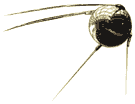 |
|||
 |
|||
In 1957, the Russians launched the first artificial
satellite,
Sputnik.
The United States was near hysterics thinking of
that little, metal ball orbiting the globe overhead. The U.S. didn't
want the Russians to own
Above losing a space-race, the biggest fear for the
world in the 1950's was the threat of a nuclear war. Dropping atomic
bombs on Japan demonstrated the incredibly destructive power of nuclear
weapons, and both sides had the bomb now. While some research centers
worked on making weapons even more destructive, other researchers studied
how to survive an atomic war. Protecting the nation's modes of communication
was considered one of the most critical priorities. Scientists at the RAND Corporation, a think-tank devoted
to national defense, studied several possibilities. One of their scientists,
Paul Baran, theorized that a decentralized
network with several possible
routes between any two points could keep the channels open for communication.
If a few of the routes in the network were destroyed in a nuclear attack,
messages would be rerouted automatically. In order to do this, though,
he realized that the messages would need to be split up and sent as
separate blocks. If the message was cut up into blocks, each could
travel along any route that connected the source to the destination
and at least part of the message would make it through.
In 1965, Baran found funding from
the Air Force, but the project was plagued with bureaucratic problems.
Earlier in
1961,
Leonard Kleinrock wrote his Ph.D.
thesis at MIT on a similar block switching idea. Also, across the Atlantic
in Britain, Donald Watts Davies was working on a block-switching scheme
for the British National Physical Laboratory (NPL). However, Davies
had a different name for it; he called the blocks "packets."
Flash 3 Demo of Packet Switching![]() The Cold War
Heats Up
The Cold War
Heats Up
 outer space without a fight, so the old soldier,
President
Eisenhower, called up some new troops, the nation's scientists and engineers,
to battle in the Cold War.
outer space without a fight, so the old soldier,
President
Eisenhower, called up some new troops, the nation's scientists and engineers,
to battle in the Cold War.  Baran was afraid that the project was doomed to fail because of the
people put in charge of it, so he withdrew his request because he feared
a failure would ruin any future prospects. He gave up on the idea,
but he didn't know that other engineers were already working on the
same idea.
Baran was afraid that the project was doomed to fail because of the
people put in charge of it, so he withdrew his request because he feared
a failure would ruin any future prospects. He gave up on the idea,
but he didn't know that other engineers were already working on the
same idea.
Copyright
© 1998, PBS Online, Inc. All Rights
Reserved.
Site Designed and Developed by
OPB Learning Media